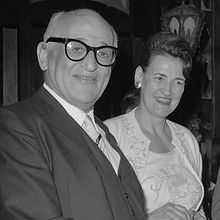Max Tak
Max Tak (born August 9, 1891 as Marcus Tak in Amsterdam , † August 7, 1967 in New York City ) was a Dutch musician , film composer , conductor , violinist , orchestra conductor and foreign correspondent .
Education and film work
Born in Marcus Tak, he came from a Jewish family who specialized in the manufacture of diamond cutting tools. He received extensive violin instruction from Alexander Schmuller and took composition lessons from Cornelis Dopper . Tak made his debut as a professional musician in 1906 during his training. In the following years he initially hired himself as a theater and dance orchestra musician - among other things he was first violinist in the Concertgebouw Orchestra - and made tentative contacts with cinematography during the silent film era. He arranged silent film compositions and also made an attempt as a film composer. Since the opening of the Abraham Tuschinski-Lichtspieltheater in October 1921, Max Tak worked as a musician for this cinema.
With the dawn of the sound film age, Tak turned more intensively to the celluloid medium, which was now also interesting for musicians, and began to work intensively as a film composer. In just seven years of Dutch sound film making - from the introduction of the sound film (1933) to the occupation of Holland by the German Wehrmacht (1940) - Tak wrote scores for numerous entertainment productions, including various productions of Jews who had fled Hitler's Germany such as Rudolf Meinert ( " Het meisje met den blauwen hoed "), Hermann Kosterlitz (" De kribbebijter "), Max Nosseck (" Oranje Hein "), Kurt Gerron (" Merijntje Gijzen's jeugd "), Friedrich Zelnik (" Vadertje Langbeen ", " Morgen gaat het beter ”) and Ludwig Berger (“ Pygmalion ”,“ Ergens en Nederland ”). This made Tak the busiest film composer in his country in the prewar period.
Occupation, escape and exile in the USA
As a result of the German attack on the Netherlands on May 10, 1940, the Jewish musician was largely sidelined. In October 1940 he was forced to leave the "Aryanized" Tuschinski cinema, now called the Tivoli Theater, and Dutch film production also came to a complete standstill for five years. In 1941, Tak managed to escape to Cuba via Belgium , France and Spain by ship . He first landed on the Caribbean island of Curaçao and settled in New York in the spring of 1943, where he continued his compositional work and also worked on the radio.
Tak stayed in the United States even after his homeland was liberated. Among other things, he worked as a foreign correspondent for the Dutch magazine Elsevier and contributed to the Dutch broadcasting company AVRO . After his death, his remains were transferred to the Netherlands in accordance with his last will and buried in the Jewish cemetery of the Muiderberg community.
MaxTak orchestra
An orchestra named after him (Orkest MaxTak) that has existed since the 1980s commemorates the most important pre-war film composer in his country and initially specialized in the new background music for silent films. Later this orchestra also dealt with modern cinema productions and animated films. In addition, a respected youth music theater branch has developed from this company.
Filmography (as composer, complete)
- 1922: Gloria Fatalis
- 1933: Hollandsch Hollywood (short film)
- 1934: Het meisje met den blauwen hoed
- 1934: De big van het regiment
- 1934: Op stap
- 1935: Uilenspiegel leeft nog
- 1935: Suikerfreule
- 1935: De kribbebijter
- 1935: Het leven is niet zoo kwaad
- 1936: Rubber
- 1936: Merijntje Gijzen's Jeugd
- 1936: Comedie om geld
- 1936: Oranje Hein
- 1936: Amsterdam by night
- 1937: Pygmalion
- 1938: Vadertje Langbeen
- 1938: Finished
- 1938: Tomorrow we have prayers
- 1939: De spooktrein
- 1939: Wit wint
- 1940: Ergens in Nederland
Literary works (selection)
- De great kunstenaars van het witte doek . Scheltens & Giltay, Amsterdam undated [1928]
- Here is New York (Photos: Kees Scherer). Bruna, Utrecht 1960 (German: Christian Wegner, Hamburg 1961; English: André Deutsch, London 1961)
- Van pierement tot Mengelberg , in: Wat niet in Baedekerstaat . The book of Amsterdam . A. J. G. Strengholt, Amsterdam 1930 (essay)
literature
- Kay Less : Between the stage and the barracks. Lexicon of persecuted theater, film and music artists from 1933 to 1945 . With a foreword by Paul Spiegel . Metropol, Berlin 2008, ISBN 978-3-938690-10-9 , p. 336.
Web links
- Max Tak in the Internet Movie Database (English)
| personal data | |
|---|---|
| SURNAME | Tak, Max |
| ALTERNATIVE NAMES | Tak, Marcus (maiden name) |
| BRIEF DESCRIPTION | Dutch musician, film composer, conductor, violinist, orchestra leader and foreign correspondent |
| DATE OF BIRTH | August 9, 1891 |
| PLACE OF BIRTH | Amsterdam |
| DATE OF DEATH | 7th August 1967 |
| Place of death | New York City |
